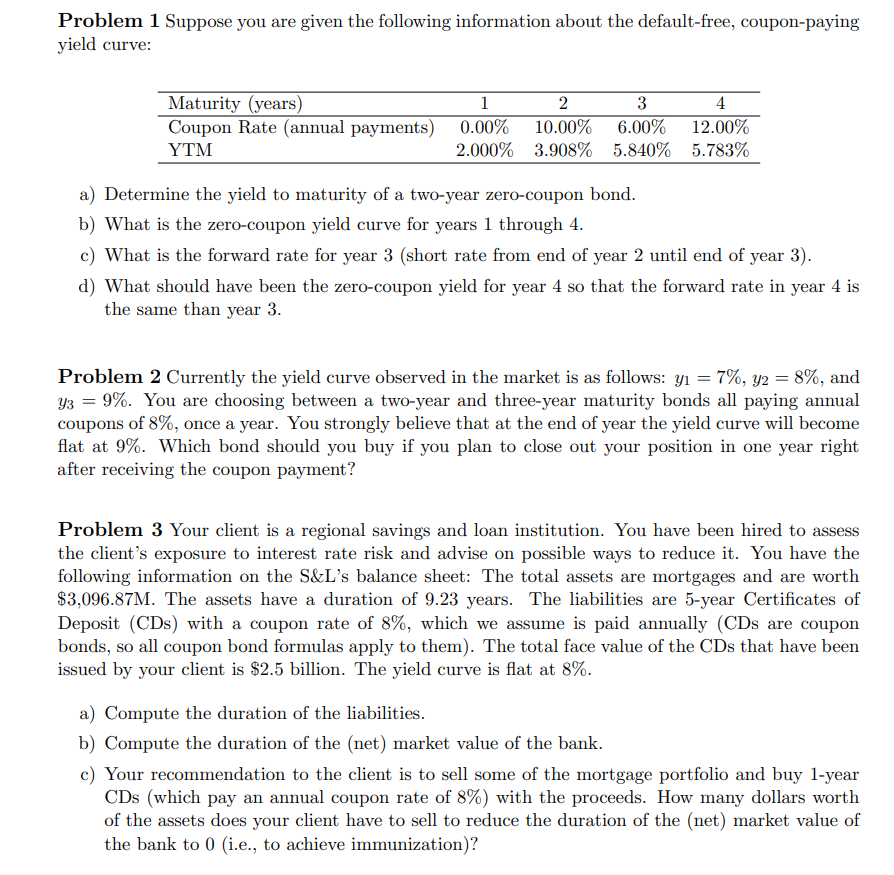Problem 2 Currently the yield curve observed in the market is as follows: y1 = 7%, y2 = 8%, and Y3 = 9%. You are choosing between a two-year and three-year maturity bonds all paying annual coupons of 8%, once a year. You strongly believe that at the end of year the yield curve will become flat at 9%. Which bond should you buy if you plan to close out your position in one year right after receiving the coupon payment?
Problem 2 Currently the yield curve observed in the market is as follows: y1 = 7%, y2 = 8%, and Y3 = 9%. You are choosing between a two-year and three-year maturity bonds all paying annual coupons of 8%, once a year. You strongly believe that at the end of year the yield curve will become flat at 9%. Which bond should you buy if you plan to close out your position in one year right after receiving the coupon payment?
Intermediate Financial Management (MindTap Course List)
13th Edition
ISBN:9781337395083
Author:Eugene F. Brigham, Phillip R. Daves
Publisher:Eugene F. Brigham, Phillip R. Daves
Chapter4: Bond Valuation
Section: Chapter Questions
Problem 23P
Related questions
Question
Could you help with number 2 and 3?

Transcribed Image Text:Problem 1 Suppose you are given the following information about the default-free, coupon-paying
yield curve:
Maturity (years)
Coupon Rate (annual payments)
1
2
3
4
0.00%
10.00%
6.00%
12.00%
ΥTM
2.000% 3.908% 5.840% 5.783%
a) Determine the yield to maturity of a two-year zero-coupon bond.
b) What is the zero-coupon yield curve for years 1 through 4.
c) What is the forward rate for year 3 (short rate from end of year 2 until end of year 3).
d) What should have been the zero-coupon yield for year 4 so that the forward rate in year 4 is
the same than year 3.
Problem 2 Currently the yield curve observed in the market is as follows: y1 = 7%, y2 = 8%, and
Y3 = 9%. You are choosing between a two-year and three-year maturity bonds all paying annual
coupons
of 8%, once a year. You strongly believe that at the end of year the yield curve will become
flat at 9%. Which bond should you buy if you plan to close out your position in one year right
after receiving the coupon payment?
Problem 3 Your client is a regional savings and loan institution. You have been hired to assess
the client's exposure to interest rate risk and advise on possible ways to reduce it. You have the
following information on the S&L's balance sheet: The total assets are mortgages and are worth
$3,096.87M. The assets have a duration of 9.23 years. The liabilities are 5-year Certificates of
Deposit (CDs) with a coupon rate of 8%, which we assume is paid annually (CDs are coupon
bonds, so all coupon bond formulas apply to them). The total face value of the CDs that have been
issued by your client is $2.5 billion. The yield curve is flat at 8%.
a) Compute the duration of the liabilities.
b) Compute the duration of the (net) market value of the bank.
c) Your recommendation to the client is to sell some of the mortgage portfolio and buy 1-year
CDs (which pay an annual coupon rate of 8%) with the proceeds. How many dollars worth
of the assets does your client have to sell to reduce the duration of the (net) market value of
the bank to 0 (i.e., to achieve immunization)?
Expert Solution
This question has been solved!
Explore an expertly crafted, step-by-step solution for a thorough understanding of key concepts.
This is a popular solution!
Trending now
This is a popular solution!
Step by step
Solved in 2 steps

Knowledge Booster
Learn more about
Need a deep-dive on the concept behind this application? Look no further. Learn more about this topic, finance and related others by exploring similar questions and additional content below.Recommended textbooks for you

Intermediate Financial Management (MindTap Course…
Finance
ISBN:
9781337395083
Author:
Eugene F. Brigham, Phillip R. Daves
Publisher:
Cengage Learning



Intermediate Financial Management (MindTap Course…
Finance
ISBN:
9781337395083
Author:
Eugene F. Brigham, Phillip R. Daves
Publisher:
Cengage Learning


